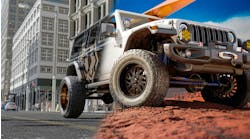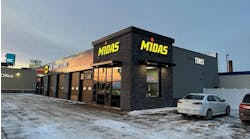In this MTD exclusive, Robert Nasca, product training manager for Hankook Tire America Corp., discusses what's driving the all-weather tire segment’s growth.
MTD: All-weather tires, as a product and concept, have been around for a while - Hankook's first all-weather offering dates back to 2008 - but the all-weather tire category has really taken off in recent years. Why?
Nasca: There are a few key reasons for the slower adoption of all-weather tires in previous years. First, the tire industry has long positioned all-season tires as a year-round solution, even though they function more as a three-season tire in many markets. This has created confusion among consumers about the distinct benefits of all-weather tires.
Changing weather patterns have played a significant role. Winter tire sales have declined, likely due to lighter snowfall in many regions and improved snow removal infrastructure.
However, winter air temperatures often remain below 45 degrees Fahrenheit, which is not ideal conditions for traditional all-season or summer tires.
In addition, as consumers increasingly prioritize versatility and convenience, all-weather tires have emerged as the ideal solution. These tires not only provide superior winter driving performance, but also offer reliable traction and grip in wet and dry conditions during the other three seasons.
Data from the U.S. Tire Manufacturers Association shows a notable upward trend in all-weather tire sales, reflecting this growing demand for year-round dependability.
All-weather tires offer three key advantages for drivers seeking adaptability in their tires, which could be considered ‘the three C’s:’ confidence, convenience and cost savings.
All-weather products offer consumers confidence when managing often unpredictable weather conditions. They also eliminate the need for seasonal tire changes in many climates, saving consumers time and money. And those cost savings are top-of-mind for many right now.
These three considerations are a key part of why demand for the all-weather segment has seen such a significant acceleration in recent years.
MTD: Why is Hankook making a significant investment in the all-weather segment? What potential do you see in terms of sales, growth, etc.? (Editor’s note: Hankook recently launched its Weatherflex GT all-weather tire.)
Nasca: While we have had all-weather offerings for some time, Weatherflex is the culmination of the past 17 years of Hankook Tire’s research and development in the all-weather segment.
The introduction of Weatherflex demonstrates our sustained commitment to providing products optimized for all-weather performance, leveraging cutting-edge technologies accumulated from the introduction of all-weather products in the (Hankook) Kinergy family and originating with our Optimo line.
Our advanced investment in the market corresponds with a growing demand for all-weather offerings from drivers, who are continuously seeking more versatility and flexibility in their tires. As mentioned, consumer demand for versatility is among the biggest growth drivers for the all-weather tire segment. Weatherflex is a step forward in meeting the needs of this growing segment, standing out with features including a 70,000-mile warranty, 3-Peak Mountain Snowflake certification, (an) asymmetrical tread design and advanced compounds for enhanced performance.
Looking at the all-weather category overall, it is growing rapidly, industry-wide. General forecasts show that the U.S. segment will grow anywhere between 5% and 7% through 2032 and additionally, all-weather tires have increased in popularity in the European market, comprising 19% of all tire sales.
MTD: Is there a consumer education component to selling all-weather tires and if so, do you have any advice for tire dealers when it comes to discussing features, benefits and applications of all-weather tires with customers?
Nasca: There is a consumer education component to selling any tire and all-weather tires are not exempt. Many consumers may not realize the difference between an all-weather and an all-season offering. For example, a consumer may note they have experienced less snow accumulation in recent years and with it, assume an all-season product will satisfy their driving requirements. However, an important nuance of all-weather tires is not only their tread design, but also their compound, which is designed to stay pliable and operable in colder atmospheric temperatures. It is important for dealers to help differentiate these sometimes-subtle nuances and steer customers toward a tire that best suits their driving habits and environment.
At the same time, it is always essential for dealers to take time to understand those individual driving needs. Where and how often customers are driving will directly influence the offerings that are the best fit for them.





